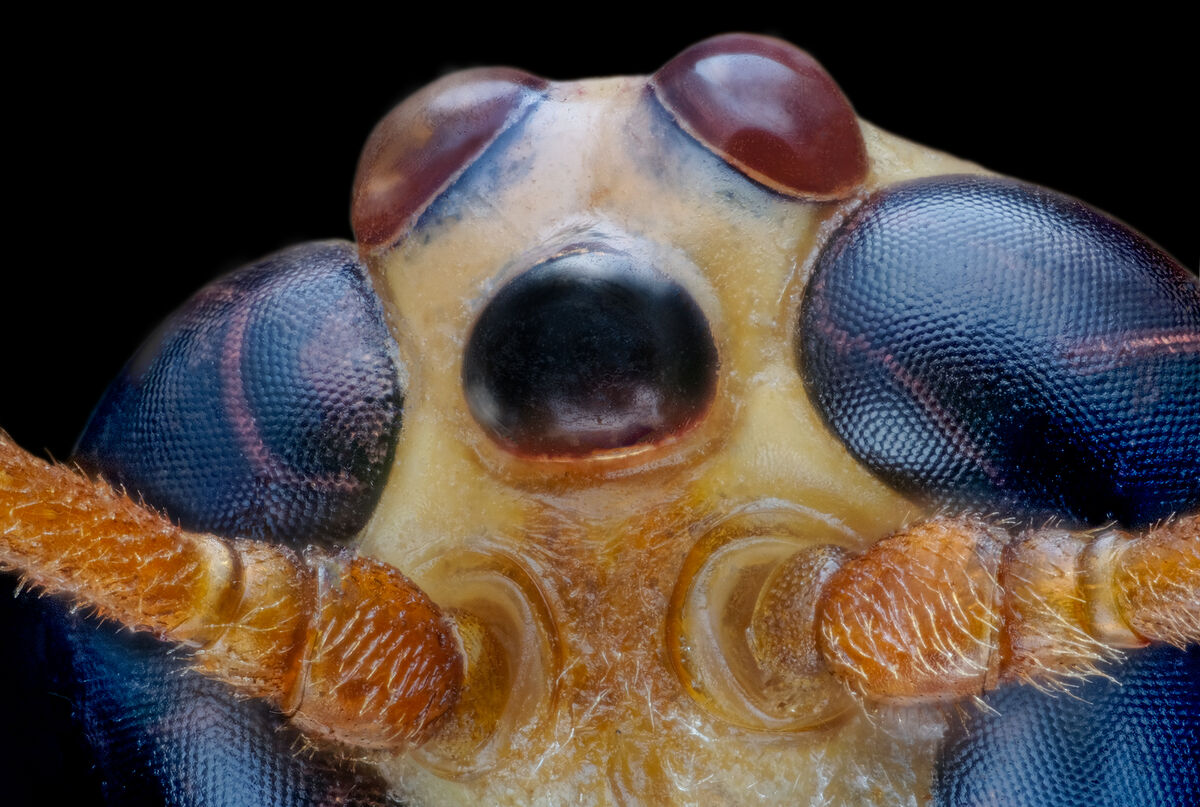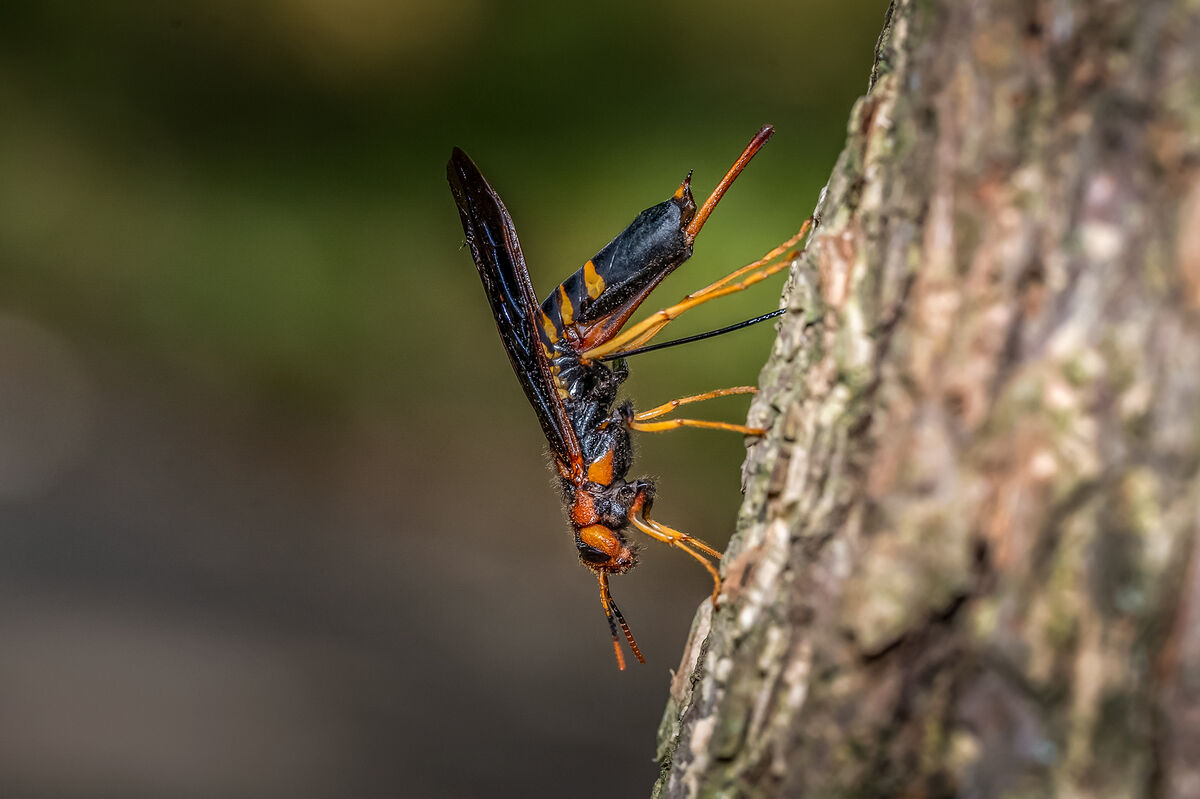Focused Stacked Image of an Ichneumon Wasp Eyes
Jan 5, 2024 17:05:35 #
This is a focused stacked image of my preserved Ichneumon Wasp using a 10X microscope objective as the optic for the camera. I've included a snapshot of it staged before the camera to show a perspective of its size and the working distance of the subject and the microscope objective.
"Ichneumons are the largest family of any of the animals, with some 60,000 to 100,000 species worldwide. They are common and can be found in nearly all habitats. The name “ichneumon” comes from Greek words meaning “tracker” and “footprint,” and the females of these parasitic wasps certainly do hunt for, and track down, their various host species."
"The young of ichneumons are mostly internal parasitoids of insect larvae in families including the beetles; the butterflies and moths; and the ants, bees, and wasps; plus flies and spiders. The mother ichneumon typically inserts her eggs into the body of the host — usually a grub or caterpillar — and the hungry larval ichneumons, devouring their hosts from the inside, usually end up killing their hosts by the time they are ready to pupate and become adult ichneumons. The fact that they usually end up killing their hosts explains why they are called parasitoids as opposed to parasites."
"Ichneumons are the largest family of any of the animals, with some 60,000 to 100,000 species worldwide. They are common and can be found in nearly all habitats. The name “ichneumon” comes from Greek words meaning “tracker” and “footprint,” and the females of these parasitic wasps certainly do hunt for, and track down, their various host species."
"The young of ichneumons are mostly internal parasitoids of insect larvae in families including the beetles; the butterflies and moths; and the ants, bees, and wasps; plus flies and spiders. The mother ichneumon typically inserts her eggs into the body of the host — usually a grub or caterpillar — and the hungry larval ichneumons, devouring their hosts from the inside, usually end up killing their hosts by the time they are ready to pupate and become adult ichneumons. The fact that they usually end up killing their hosts explains why they are called parasitoids as opposed to parasites."
Jan 5, 2024 17:22:09 #
Jan 5, 2024 18:08:00 #
sippyjug104 wrote:
This is a focused stacked image of my preserved Ic... (show quote)
Masterful, and you have a great looking lab




 Have you published? I know, a dumb question to ask after all this time, but you SHOULD have several books and shots in magazines or journals. Just curious, Sippy. And nosey 🙄
Have you published? I know, a dumb question to ask after all this time, but you SHOULD have several books and shots in magazines or journals. Just curious, Sippy. And nosey 🙄Jan 5, 2024 18:24:51 #
Jan 5, 2024 18:43:44 #
Jan 5, 2024 19:17:48 #
Jan 5, 2024 19:25:53 #
joecichjr wrote:
Masterful, and you have a great looking lab img ... (show quote)
Joe, thanks for the kind reply. I am a hobbyist with a curiosity about the small things around us. I find insects and flowers to be among Mother Nature's many wonders when viewed closeup or under magnification.
This is another member of the Ichneumon wasp family (it's quite a large family) that I came across during one of my walkabouts in the process of depositing its egg in a larva that she sensed living under the tree bark (how the heck do they know there's a larva under there?) If you look closely, you will see the ovipositor that she is using to drill into the bark. It's that "black thing" under her. The "thing" sticking out her rear is the sheath that she keeps the ovipositor in. How cool is that?
Jan 5, 2024 22:58:30 #
UTMike wrote:
Amazing result and interesting narrative, Gary!
Thanks, UTMike. They are quite interesting little creatures.
Jan 5, 2024 23:00:38 #
Curmudgeon wrote:
Nice Sippy and thanks for showing the full body shot too
Thanks, Curmudgeon. At times I like to show how I set up the session and it also gives a perspective as to the size of the specimen.
Jan 5, 2024 23:01:02 #
Toment wrote:
Great work
Thanks for sharing
Thanks for sharing
Thanks, Toment. I appreciate your stopping by.
Jan 5, 2024 23:02:15 #
kpmac wrote:
Very nice, sippy.
Thanks, Kpmac. There are plenty of them down your way although they are quite small so you would have to look carefully to see them.
Jan 6, 2024 05:43:56 #
Sippy, Bit by Bit you educate us regarding the complexity of the insect world. "Bug Week" is more real-life than "Shark Week." We are much more likely to be stung, bitten, or host to an under-the-skin larva than being bitten by a shark.
Jan 6, 2024 06:02:30 #
sippyjug104 wrote:
This is a focused stacked image of my preserved Ic... (show quote)
Fantastic image!!!
Jan 6, 2024 07:24:11 #
Jan 6, 2024 07:36:31 #
If you want to reply, then register here. Registration is free and your account is created instantly, so you can post right away.











